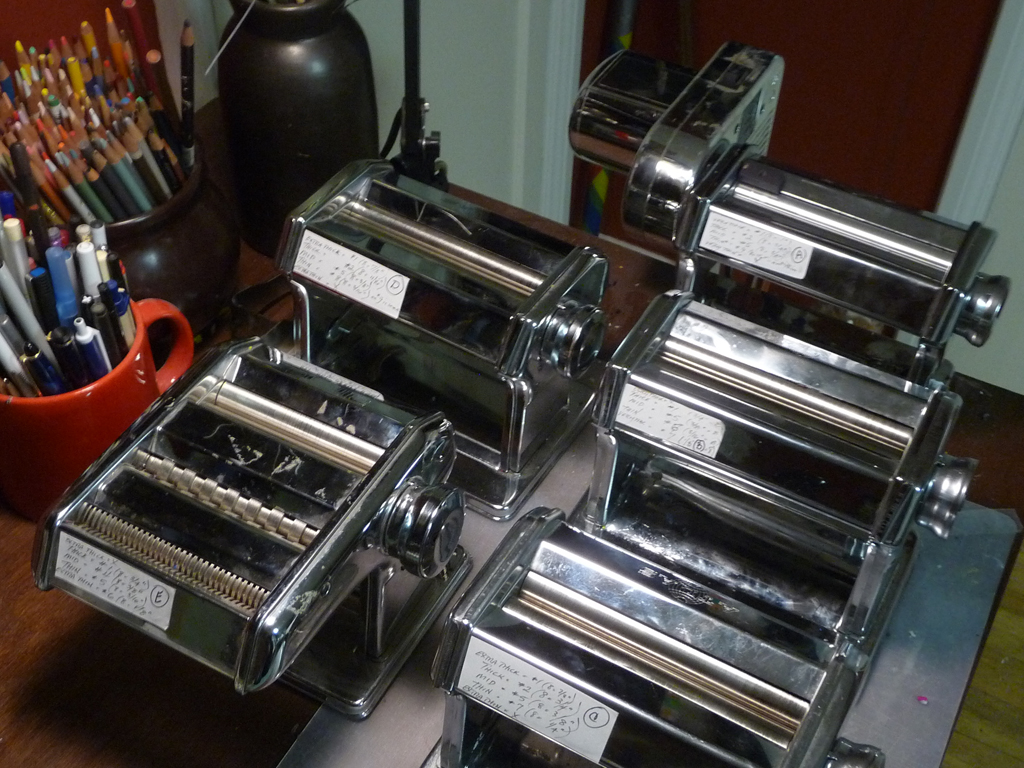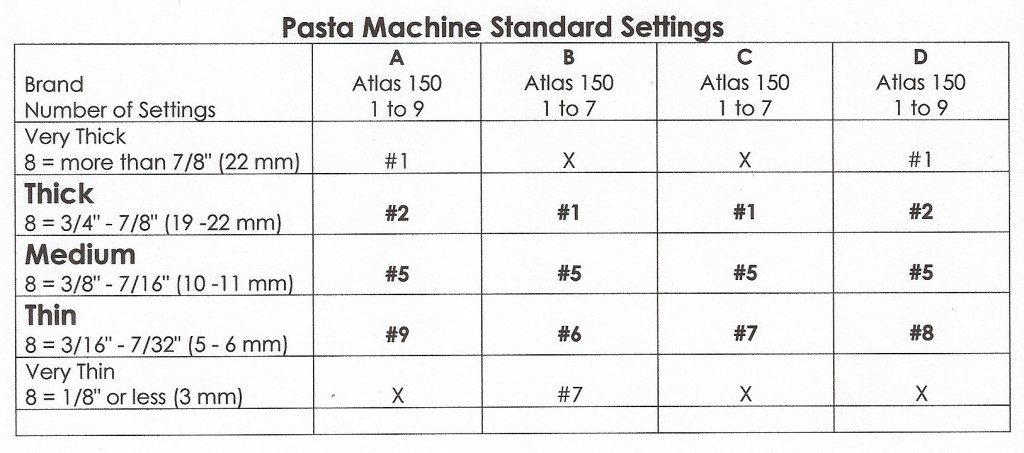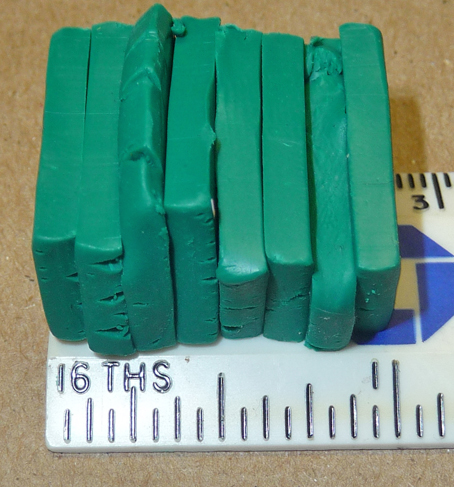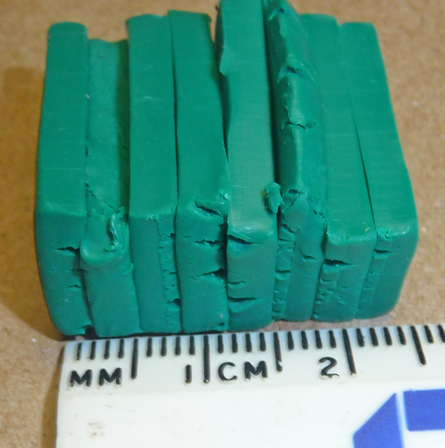 After struggling to write the instructions for a new project, I realized how crazy it is that we do not have standard settings on pasta machines. We can’t just use the numbers because every pasta machine is different. Sometimes the thickest setting is #1, sometimes the thinnest setting is #1. Sometimes the thickest setting is over 1/8″ thick and sometimes it is closer to 1/16th”. This causes all kinds of problems in projects where the thickness of the sheet is critical to the technique.
After struggling to write the instructions for a new project, I realized how crazy it is that we do not have standard settings on pasta machines. We can’t just use the numbers because every pasta machine is different. Sometimes the thickest setting is #1, sometimes the thinnest setting is #1. Sometimes the thickest setting is over 1/8″ thick and sometimes it is closer to 1/16th”. This causes all kinds of problems in projects where the thickness of the sheet is critical to the technique.
I have a simple solution. Let’s standardize at least three settings – call them “thick”, “medium” and “thin” – and label our pasta machines.
1. Write down the numbers on your pasta machine dial on a sheet of scrap paper. Some pasta machines have only 6 settings, some as many as 9 settings.
2. Sheet a small piece of clay at the thickest setting and then cut it into 8 pieces. Line the pieces up, measure the width, and make a note of the width. In the illustration below my note would read, #1 = 1″ (24 mm in metric)
Why eight sheets? We could try to measure the thickness of just one sheet but this is difficult to do with any accuracy especially at the thinnest settings. Eight sheets gives us something to measure easily.
3. Do the same thing for all of the settings.
4. Once you have all the widths documented, identify these five settings –
Very Thick 8 sheets = More than 7/8″ (22+ mm)
Thick 8 sheets = 3/4″ – 7/8″ (19-22 mm)
Medium 8 sheets = 3/8″ – 7/16″ (10-11 mm)
Thin 8 sheets = 3/16″ – 7/32″ (5 – 6 mm)
Very Thin 8 sheets = 1/8″ or less (3 mm or less)
5. Label the pasta machine. I just use a file label.
Not all pasta machines will have all five settings – this machine did not have a very thin setting and the thinnest setting was not even as thin as it should be. But in my experience, pretty much all pasta machines have settings that correspond to the middle three thicknesses.
I’d like to suggest that teachers start using just these three settings – “thick”, “medium”, and “thin” – and that all workshops start with students finding the numbers on their pasta machine that are closest to these settings.
You can of course use all your settings not just these three. I could, for example, say “Sheet the clay at your medium-thick setting.” You would know to sheet it between your thick and medium settings.
If you have more than one pasta machine put labels on all of them. Here’s the chart for my four Atlas 150’s. As you can see they are all different.

I like to identify my pasta machines with a letter so that I can easily make notes when I’m working on a project. A is my motorized pasta machine. B is my old Atlas that I only use for its very thin setting, C and D are my traveling pasta machines.
With all the new pasta machines on the market the variations in thickness are extreme. The Dream Machine has a #1 setting where 8 sheets = well over 1″. Compare that to one of my Atlas 150’s where 8 sheets = 3/4″ and you can see how hard it is for artists spread out all over the world to get the same results. Standardizing the settings would make it much easier to teach/follow instructions and get consistent results no matter what pasta machine you are using!




January 20, 2012 at 11:56 pm
This is a great topic, thanks for bringing it up Maggie. We totally need to intoduce a standard! I was the one that started this discussion with Sage at TPA’s and I have to agree that the playing card system is the easiest one to implement. There is no stacking or measuring. All that is involved is a deck of playing cards (Sage researched this and playing card thickness is pretty standard regardless of where u live). Put your machine on the thinnest setting. How many cards go through? Write down the #. Change to the next setting, how many cards go through? Write down the # etc. Do this for all settings. Now,write that # on your PM beside the setting (or notch) that corresponds . Then,you can also sheet a piece of clay for each setting, cut out a shape from each sheet with a cookie cutter, bake it, write the # of card thickness on each sample, puch a small hole in each, put a ring thru all of your chips and keep it close at hand. The next time you are about to create with your clay just look at your chips and you will be able to “Feel” the thickness you want to achieve for that project. Read the # on that sample (it’s the card thickness remember) ,then glance at your PM and set the dial to the corressponding # that you’ve written on there!!! Easy !!! No math involved what-s0-ever.
Now in the future when writiing up a tutorial we can say 4 CT or 8 CT (cards thick). That sounds like an easy standand to me. AND if metal clay artists are using one of our tutorials they will completely understand, They may not use pasta machines but the CT #’s will still be relavent to them, they will just lay the right number of cards down in 2 stacks on the table and roll the clay out inbetween them.
Sorry for being so long winded here!!
What does everyone think????
Let’s make 2012 the year that we standardize this! 🙂
Looking forward to hearing your thoughts.
Wendy
January 10, 2012 at 4:42 am
Hi Claire – The range of thicknesses is getting bigger and bigger. That’s why we need some standard thicknesses especially for use in books, articles, tutorials and workshops. The idea is to find the thickest and thinnest settings that all pasta machines have in common, and then pick one setting in between to be the middle/medium setting. I’m proposing that we name the setting that makes sheets closest to 3/32″ (19 mm) the THICK setting. Times that by 8 and its 3/4″. Times it by 10 and its just under 1″. Sometimes this is not the thickest setting but it is a setting that is on almost all pasta machines.
January 10, 2012 at 3:28 am
Hi Helen – I don’t like the idea of using playing cards as the standard. I know the PMC community uses cards as their standard but they rarely need sheets that are as thick as 1/8″ and they do not use pasta machines. We could add a column for playing card count for folks who might not have pasta machines as an optional way to measure thickness but I think the pasta machines are the way to go.
January 10, 2012 at 3:17 am
A great idea, Maggie. From your article, I am amazed at the difference between machines and as you say, with people all over the world using them the results could be quite different. I knew that some brands had the numbers going the other way round but you assume that the range of thicknesses would be fairly similar. This is something I will definitely bare in mind when referring to different thickness settings. Thank you so much for sharing this idea.
January 10, 2012 at 2:27 am
Hi all, I’m following this thickness standardization topic with great interest as I write tutorials and am currently working on a book. Sage with Polymer Arts magazine has proposed using playing card thickness as the standard as they do with metal clay. She has written up her thoughts in her Winter 2011 issue as well as on her Facebook site (getting lots of comments). Maggie/others what do you think about that idea?
January 9, 2012 at 11:04 pm
Hi Ulrike – You are right. I was originally thinking the thick setting would be anything between 3/4 and just under 1″ (20 -24 mm) but changed it to between 3/4 and 7/8″ and forgot to change the charts. To be more accurate, thick should be = 19 – 22 mm. If its over 22 mm then its very thick. I will change the charts. Thanks for catching this so fast!!!
January 9, 2012 at 10:00 pm
Wonderful idea.
But I’m a little bit confused (sorry – I’m German and used to think in mm)
7/8 Inch are – according to what I learned about converting Inch into cm – 2,22cm. So is your #1 more than 7/8 Inch oder more than 24mm?
Or to ask the other way around: is my #1, which is 2,8mm thick (makes 22,4mm if I take 8 sheets) very-thick (according to your Inch declaration) or thick (according to your mm declaration)?
– Ulrike
January 9, 2012 at 10:37 am
Hi Desiree – I do have more pasta machines but they are over at TaborSpace for our guild to use – I will need to label them ASAP! I’m not sure what to do when the rollers are skewed. It seems the newer pasta machines are always a little bit off. Usually its most apparent in the thin settings. If its a real problem, you could run the sheets on the left, center and right of each setting and compare the stacks of 8 to see how much the rollers are off kilter.
January 9, 2012 at 10:18 am
I love the idea of attempting a standardization. Often, I’ve struggled in my instructions as I moved away from quantifying to qualifying a thickness. I ended up using “thickest, a little less than thickest or second thickest, medium, as thin as you can, etc.” terms. But I worry qualified terms makes newbies nervous. They want a number because that’s what is showing on the dial.
Not to put a damper on things, but how would you ask folks to account for the thickness variation from left to right when taking precise measurements of the gap? I know a lot of people (including me) who have pasta machines where one side has a slightly (or obviously) wider gap than the other side, which results in the sheet coming through a little longer on the narrower side.
BTW, I think you should get a few more pasta machines. I have 8-9 and I don’t want to be the only one with my condition – MPMS (multiple pasta machine syndrome)! 🙂 I even have one of those baby PMs (110mm wide). They’re so cute.
January 9, 2012 at 7:52 am
Hi Nancy – Yep – should have said this is for folks working in clay. Though I imagine cooks have similar trouble with recipes. I did find this on Jamie Oliver’s site when I was researching for this post . . .
Roller Setting Uses
1 or 2…………..Kneading and thinning dough
3…………………Thick noodles
4…………………Egg noodles
4 or 5…………..Lasagna noodles, fettucine, spaghetti, and ravioli
6 or 7…………..Tortellini, thin fettucine, and linguine fini
7 or 8…………..Very thin “angel-hair” type pasta/capellini or very fine linguine
January 9, 2012 at 7:47 am
Thanks Debbie. I’ve been using “thickest, middle and thinnest manageable setting” but in my last round of workshops a few people had Dream Machines and their thickest setting was almost twice as thick as a few of the older model Atlases. The thinnest manageable setting is even more variable. The striped split rings needed much more accuracy to work. It was very frustrating.
Did you notice that ideally the medium setting is 1/2 as thick as the thick setting and that the thin setting is 1/2 as thick as the medium setting? This will hopefully make it easier to remember – just think of the thick setting as 8 sheets = 3/4″ (20 mm) and go down from there.
I have high hopes that soon everyone in the polymer community will start using these standard for sheets at a thick, medium and thin settings. I agree that it sure would make life lots easier!
January 9, 2012 at 6:38 am
Yep, this would make life a LOT easier when claying… or teaching! I’m certainly going to label my machine next time I sit at it…. and will remember to use ‘thick, medium, thin’ when teaching. I gave up numbers a long time ago anyway, for the same reason.
Thanks, Maggie!
January 8, 2012 at 9:10 pm
You are so smart sometimes it kills me! I am doing it today.
January 8, 2012 at 9:20 am
Of course you were talking about clay! Here I am thinking what a switch for you to write about pasta! LOL. I have a Kitchen Aid pasta attachment and the thicknesses are different from my grandmother’s old manual machine. I had to get used to that for pasta making. I should do your experiment with pasta.